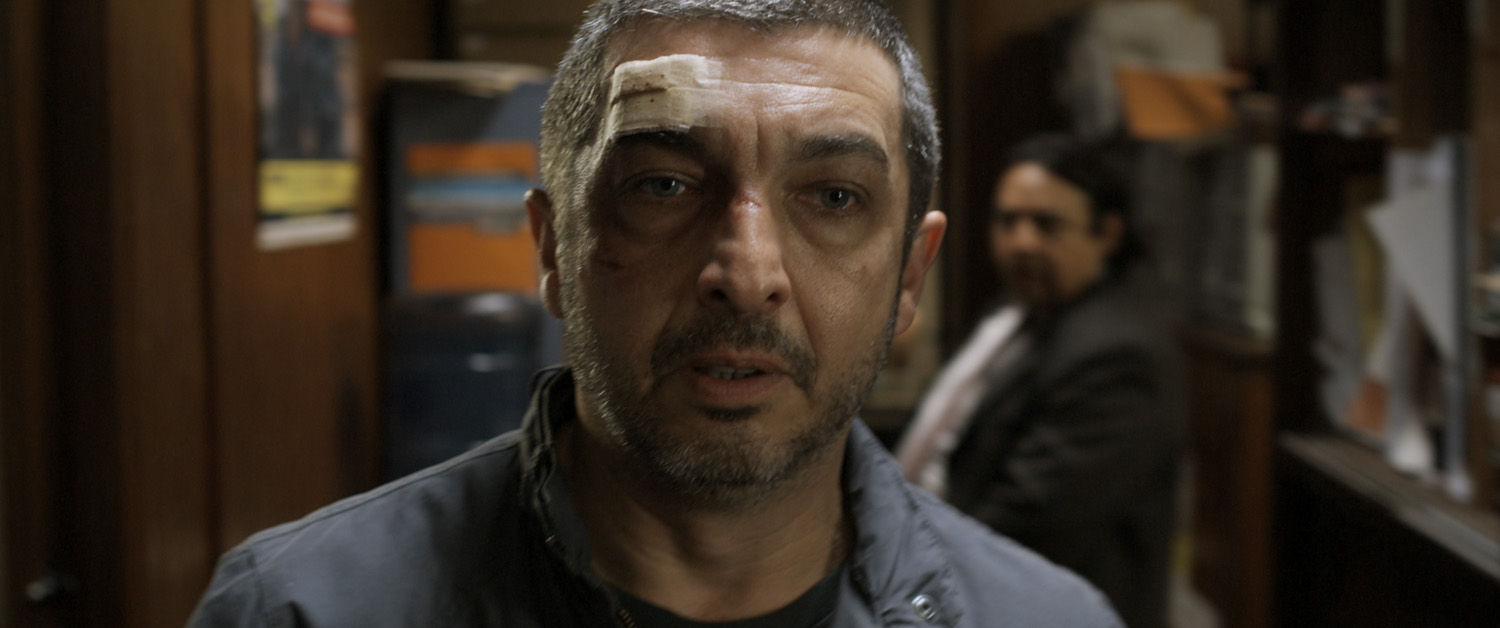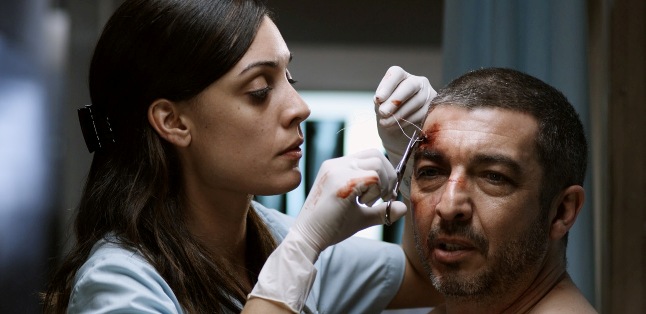Carancho | reviews, news & interviews
Carancho
Carancho
Ambulance-chasing is given a noirish spin on the dark streets of Buenos Aires

In the UK we call them ambulance-chasers, those personal injury lawyers who prey on the victims of accidents, encouraging them to seek compensation, in return for a tidy fee. The Argentines, as the title of Pablo Trapero’s new film suggests, have their own word for this mucky breed – vultures.
Deeply flawed Buenos Aires lawyer Héctor Sosa (Ricardo Darín, pictured below) even looks a little vulture-like, with his hooked nose and hungry, ravaged features. Darín, Argentina’s greatest actor, has the perfect face for seedy no-hoper:; when he played a grifter in the seminal Nine Queens, he resembled a weasel. With a face like his, we’ll believe anything the actor wants, no questions asked.
 We first meet Sosa on the receiving end of an almighty beating, having clearly landed on a grieving family while the corpse of their loved one is still warm. Within minutes, he is back on his feet and the first on the scene of a car accident, even cradling the victim when the ambulance arrives. He then follows the medics back to the hospital, talons bared, eager to sign up his new client.
We first meet Sosa on the receiving end of an almighty beating, having clearly landed on a grieving family while the corpse of their loved one is still warm. Within minutes, he is back on his feet and the first on the scene of a car accident, even cradling the victim when the ambulance arrives. He then follows the medics back to the hospital, talons bared, eager to sign up his new client.
Sosa’s modus operandi includes bribing ambulance drivers and police, and even staging his own accidents, with willing accomplices happy to break a leg for an insurance company cheque. But when he meets a new and idealistic doctor, Lujan (Martina Gusman) Sosa not only falls in love, but realises that carrion no longer agrees with him. He wants out. The trouble is, the shady legal firm he works for is not particularly keen to lose his talents.
Trapero’s theme is the dark trade in people’s suffering, conducted by a profession whose lack of ethics borders on illegality. The director’s mode of expression is the thriller – not film noir, as some have suggested, though he borrows a few noir traits in concocting a nocturnal tale of corruption, forlorn romance and a doomed bid for redemption.
 This is a film of two halves. The opening is fabulous, as Trapero conjures a world of dingy, undernourished hospitals and protagonists who only seem to exist in the night, on joyless autopilot, which recalls Scorsese’s Bringing Out the Dead and, more so, Cristi Puiu’s remorseless critique of Romanian health care, The Death of Mr Lazarescu.
This is a film of two halves. The opening is fabulous, as Trapero conjures a world of dingy, undernourished hospitals and protagonists who only seem to exist in the night, on joyless autopilot, which recalls Scorsese’s Bringing Out the Dead and, more so, Cristi Puiu’s remorseless critique of Romanian health care, The Death of Mr Lazarescu.
This section also highlights Trapero’s great strength, of dallying with genre while retaining authentic mood and milieu (his cop drama El bonaerense is one of the most atypical, and greatest of cop dramas, Lion's Den – starring Gusman – a most refreshing prison movie). Here, the best of his genre pretensions sees Sosa endure one physical battering after enough, as any noir anti-hero worth his salt, each time brushing himself off and continuing as if nothing has happened.
Perhaps the film’s standout moment is one of courtship and calm in an all-night café. Being a cynical chap, Sosa gambles for a kiss on the belief that four cars will jump the next red light. He and Lujan watch through the window and count the cars, both willing the same result. The simplicity of the direction and acting is a joy to watch.
However, the second half, as Trapero is called upon to make something of his plot, is its own car wreck. No care is given to back story (why is Lujan, otherwise such a sensible young woman, shooting up?), too much time to the unravelling of Sosa’s business relationships and a spiralling, suddenly absurd course of violence. As Trapero edges ever closer to the mainstream, he would be wise to remember that one of his best qualities is his restraint.
Watch the trailer to Carancho
Add comment
The future of Arts Journalism
You can stop theartsdesk.com closing!
We urgently need financing to survive. Our fundraising drive has thus far raised £49,000 but we need to reach £100,000 or we will be forced to close. Please contribute here: https://gofund.me/c3f6033d
And if you can forward this information to anyone who might assist, we’d be grateful.

Subscribe to theartsdesk.com
Thank you for continuing to read our work on theartsdesk.com. For unlimited access to every article in its entirety, including our archive of more than 15,000 pieces, we're asking for £5 per month or £40 per year. We feel it's a very good deal, and hope you do too.
To take a subscription now simply click here.
And if you're looking for that extra gift for a friend or family member, why not treat them to a theartsdesk.com gift subscription?
more Film
 The Mastermind review - another slim but nourishing slice of Americana from Kelly Reichardt
Josh O'Connor is perfect casting as a cocky middle-class American adrift in the 1970s
The Mastermind review - another slim but nourishing slice of Americana from Kelly Reichardt
Josh O'Connor is perfect casting as a cocky middle-class American adrift in the 1970s
 Springsteen: Deliver Me From Nowhere review - the story of the Boss who isn't boss of his own head
A brooding trip on the Bruce Springsteen highway of hard knocks
Springsteen: Deliver Me From Nowhere review - the story of the Boss who isn't boss of his own head
A brooding trip on the Bruce Springsteen highway of hard knocks
 The Perfect Neighbor, Netflix review - Florida found-footage documentary is a harrowing watch
Sundance winner chronicles a death that should have been prevented
The Perfect Neighbor, Netflix review - Florida found-footage documentary is a harrowing watch
Sundance winner chronicles a death that should have been prevented
 Blu-ray: Le Quai des Brumes
Love twinkles in the gloom of Marcel Carné’s fogbound French poetic realist classic
Blu-ray: Le Quai des Brumes
Love twinkles in the gloom of Marcel Carné’s fogbound French poetic realist classic
 Frankenstein review - the Prometheus of the charnel house
Guillermo del Toro is fitfully inspired, but often lost in long-held ambitions
Frankenstein review - the Prometheus of the charnel house
Guillermo del Toro is fitfully inspired, but often lost in long-held ambitions
 London Film Festival 2025 - a Korean masterclass in black comedy and a Camus classic effectively realised
New films from Park Chan-wook, Gianfranco Rosi, François Ozon, Ildikó Enyedi and more
London Film Festival 2025 - a Korean masterclass in black comedy and a Camus classic effectively realised
New films from Park Chan-wook, Gianfranco Rosi, François Ozon, Ildikó Enyedi and more
 After the Hunt review - muddled #MeToo provocation
Julia Roberts excels despite misfiring drama
After the Hunt review - muddled #MeToo provocation
Julia Roberts excels despite misfiring drama
 London Film Festival 2025 - Bradley Cooper channels John Bishop, the Boss goes to Nebraska, and a French pandemic
... not to mention Kristen Stewart's directing debut and a punchy prison drama
London Film Festival 2025 - Bradley Cooper channels John Bishop, the Boss goes to Nebraska, and a French pandemic
... not to mention Kristen Stewart's directing debut and a punchy prison drama
 Ballad of a Small Player review - Colin Farrell's all in as a gambler down on his luck
Conclave director Edward Berger swaps the Vatican for Asia's sin city
Ballad of a Small Player review - Colin Farrell's all in as a gambler down on his luck
Conclave director Edward Berger swaps the Vatican for Asia's sin city
 London Film Festival 2025 - from paranoia in Brazil and Iran, to light relief in New York and Tuscany
'Jay Kelly' disappoints, 'It Was Just an Accident' doesn't
London Film Festival 2025 - from paranoia in Brazil and Iran, to light relief in New York and Tuscany
'Jay Kelly' disappoints, 'It Was Just an Accident' doesn't
 Iron Ladies review - working-class heroines of the Miners' Strike
Documentary salutes the staunch women who fought Thatcher's pit closures
Iron Ladies review - working-class heroines of the Miners' Strike
Documentary salutes the staunch women who fought Thatcher's pit closures
 Blu-ray: The Man in the White Suit
Ealing Studios' prescient black comedy, as sharp as ever
Blu-ray: The Man in the White Suit
Ealing Studios' prescient black comedy, as sharp as ever

Comments
Quite enjoyed this movie,